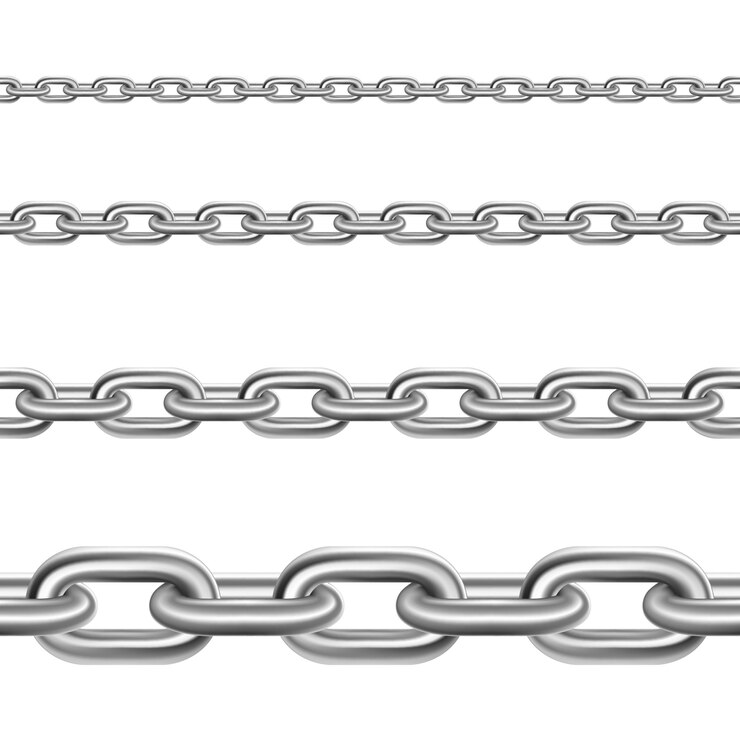Stainless steel chains, celebrated for their combination of strength, durability, and beauty, play a fundamental role in numerous applications. From the simple allure of a necklace to the robust functionality in industrial settings, the correct choice of chain is crucial to ensure both aesthetics and performance.
Understanding Stainless Steel
Stainless steel’s journey began in the early 20th century, offering a corrosion-resistant alternative to traditional steel. Its blend of chromium with steel gives it a unique edge in terms of resilience and appearance. The advantages of stainless steel—be it its resistance to rust, inherent strength, or gleaming appearance—make it a preferred choice in numerous applications.
Different stainless steel types, such as 304, 316, and 316L, cater to varied uses. Each type has a unique composition that offers specific benefits. For instance, 316L, with its added molybdenum, offers heightened corrosion resistance, making it ideal for marine applications.
Factors to Consider When Choosing a Stainless Steel Chain
Purpose of Use
When purchasing a stainless steel chain, understanding its intended use is pivotal. For jewelry, the chain needs to complement the pendant both aesthetically and in terms of weight-bearing. A dainty chain might not suit a heavy pendant, while a bulky chain might overpower a delicate one.
For industrial purposes, factors such as the chain’s load-bearing capacity, environment, and frequency of use take center stage. Maritime applications, for instance, demand chains that can withstand prolonged exposure to saltwater, emphasizing the importance of a chain’s corrosion resistance.
Chain Design and Styles
The design of a stainless steel chain is more than just its aesthetic appeal—it speaks to its functionality. Different link styles, like box, cable, curb, or rope, offer varied strengths and appearances, catering to diverse tastes and uses.
Considering chain thickness and length is equally crucial. While thicker chains generally promise higher durability, their weight and appearance might not be suitable for every purpose. Likewise, the chain’s length can influence both its functionality and style quotient.
Tensile Strength
Tensile strength—the maximum amount of tensile stress a material can withstand without breaking—is vital when evaluating a chain’s suitability. For applications requiring the chain to bear significant weight or force, understanding its tensile strength becomes non-negotiable.
Consider, for instance, the chains used in lifting heavy machinery. An oversight in accounting for tensile strength could lead to catastrophic failures, emphasizing the importance of meticulous selection.
Corrosion Resistance
While stainless steel inherently resists corrosion, different grades offer varying levels of protection. Understanding these differences becomes crucial when the chain is used in environments prone to corrosive elements.
For instance, a chain used near the sea or in a chemical plant would need a higher grade of stainless steel, like 316L, to ensure longevity and safe performance. Always prioritize corrosion resistance in situations where exposure to aggressive agents is inevitable.
Budget Constraints
The adage “you get what you pay for” holds for stainless steel chains. While it’s tempting to opt for cheaper options, it’s essential to ensure you’re not compromising on quality, especially if durability and strength are paramount.
That said, with a bit of research, one can strike a balance between cost and quality. Look for trusted suppliers or brands that offer competitive prices without skimping on the quality of the chain.
Maintenance and Care
Even the most robust stainless steel chains require care to maximize their lifespan. Daily practices, such as keeping the chain free from dirt and moisture, can go a long way in preserving its luster and functionality.
When it comes to cleaning, a gentle soap solution and a soft cloth usually suffice for most chains. Ensure thorough rinsing and drying to prevent water spots or staining. If the chain requires more intensive care, consider seeking professional cleaning services to restore its shine.
Mistakes to Avoid When Selecting a Chain
It’s easy to get overwhelmed with the plethora of stainless steel chain options available. However, overlooking crucial factors like weight-bearing capacity can lead to premature wear or even chain failure.
Furthermore, it’s vital to consider the environment in which the chain will be used. Opting for a lower grade of stainless steel in a corrosive environment, for example, can lead to rapid degradation. Remember, while aesthetics and cost are essential, they should never come at the price of functionality and safety.
Conclusion
Choosing the right stainless steel chain might seem daunting, but with the right knowledge and considerations, it becomes a more straightforward task. Whether you’re aiming for aesthetic appeal or uncompromising strength, informed decision-making ensures your chain serves you well for years to come.





Be First to Comment